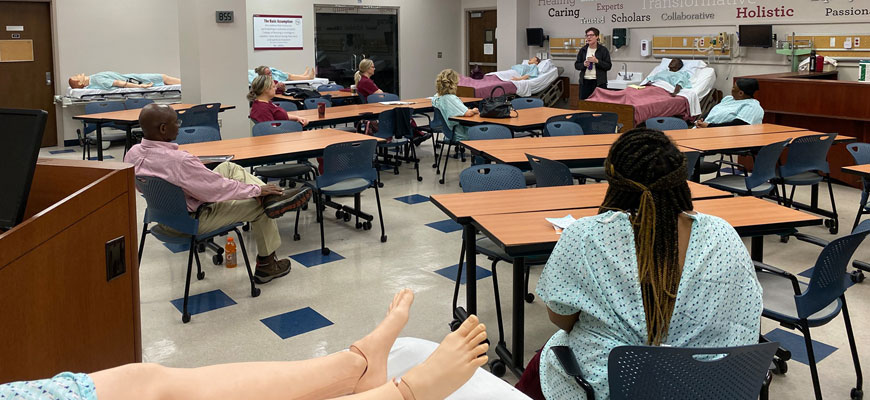
COVID-19 response: Virtual simulation keeps nursing students on track for graduation
Clinical learning makes way for virtual simulation in the wake of COVID-19 restrictions
Posted on: April 6, 2020; Updated on: April 6, 2020
By Chris Horn, chorn@sc.edu, 803-777-3687
As the coronavirus threatens health and upends daily life, members of the UofSC community family are rising to the challenge with a spirit of resilience and concern for others. See more stories.
In the wake of the COVID-19 pandemic, colleges and universities across the country have replaced face-to-face courses with digital instruction — a feat that has varied in difficulty depending on each institution’s technological talent pool.
In that regard, the University of South Carolina’s College of Nursing has an edge. The college already offers the nation’s No. 1-ranked online master’s program among public institutions and a faculty and staff skilled at delivering quality online instruction. In addition, the college participated in a national study several years ago that proved the efficacy of simulation for effective learning.
That knowledge paved the way for the college to quickly create virtual simulations of critical, hands-on experiences for eight undergraduate courses with clinical components. The college’s undergraduates are required to complete at least 1,000 hours of clinical instruction to be considered ready for professional practice.
“We do simulation all the time in our Clinical Simulation Lab — it supplements our students’ clinical experiences in health care settings. But the difference this semester is that we had to start offering the simulations and the clinical experiences remotely because of COVID-19,” says Alicia Ribar, interim associate dean for academics in the nursing college. “The students couldn’t physically come to the simulation lab or safely go to hospitals for clinicals.”
Turning hands-on nursing experiences into virtual simulations might seem a daunting task. How do you capture the reality of a serious illness or medical condition and make it come to life in digital form? In the space of three weeks, College of Nursing faculty and staff assembled a full suite of simulation experiences that will enable all its nearly 500 upper division students to achieve their learning objectives for the semester and allow seniors to graduate on time.
In some cases, the college employed virtual simulations embedded in standardized learning materials already used by students. The college also called in its troupe of “standardized patients” — people who are trained to act as patients with underlying health conditions such as congestive heart failure or diabetes — and quickly made video recordings of the patients being assessed by faculty members.
“Students watch these videos independently or they come together in small clinical groups — using Zoom or some other app — and discuss how to deliver care and why,” Ribar says. “Then their clinical faculty members debrief them and have the students explain their decisions. After that, the full-time faculty debrief the whole class to help them think through the larger implications of patient assessment.”
Students responded enthusiastically to the first week of virtual simulation, Ribar says.
“The nice thing about virtual simulation is that is allows the students to learn the same critical thinking skills as they would learn face to face with patients but in a much safer environment,” she says.
“Moving to a virtual format was a large lift for us and certainly not what we wanted to do this semester but we’ve kept in mind that our main goal was to meet the students’ learning needs and help them to develop their critical thinking skills.”
Graduating seniors this spring will get the same support from the college as past cohorts as they prepare for the national licensure exam. The four most recent cohorts of graduating seniors have achieved a 100 percent pass rate on the exam.
Jeannette Andrews, dean of the College of Nursing, says keeping the students on track for degree progression and graduation this semester has been vitally important.
“Almost all of our students want to be helping at the bedside during this time, which is quite amazing to me,” Andrews says. “They have heeded the call to an outstanding profession, and I could not be more proud of our nursing students. Our future is in good hands.”
Share this Story! Let friends in your social network know what you are reading about